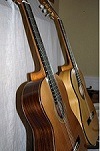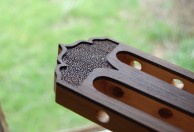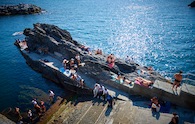Welcome to one of the most active flamenco sites on the Internet. Guests can read most posts but if you want to participate click here to register.
This site is dedicated to the memory of Paco de Lucía, Ron Mitchell, Guy Williams, Linda Elvira, Philip John Lee, Craig Eros, Ben Woods, David Serva and Tom Blackshear who went ahead of us.
We receive 12,200 visitors a month from 200 countries and 1.7 million page impressions a year. To advertise on this site please contact us.
|

|
|
RE: French Polishing
|
You are logged in as Guest
|
|
Users viewing this topic: none
|
|
Login  | |
|

   
Shawn Brock
Posts: 271
Joined: Sep. 19 2011
From: Louisville KY

|
 RE: French Polishing (in reply to Anders Eliasson) RE: French Polishing (in reply to Anders Eliasson)
|
|
|
Okay, I don't want to stick my nose in and disrupt the thread here, but I'm always trying to learn more about the luthier's ways...
1: It seems that across the board your spending about 14/15 days on FP, and this covers the stages of polishing, drying/ curing and buffing. Please correct me if I'm wrong...
2: I have seen guitars which were undergoing FP but the guitar didn't yet have the bridge on it. Is this normal? Or is it one of those things that is based on opinion? It seems like you wouldn't want FP between the bridge and the top, although you could always mask that area off and not apply finish there I guess.
I know a lot of steel string builders and have seen those guitars come to life. Lots of times they will even do most of the guitar's setup before finishing. They will string it up "in the white", set it up and let you play it... I understand that you want to wait for FP to harden before applying the tap plate and such, but does the guitar still need days of work after the finish is buffed before you send it to its new owner?
As a clumsy player, I would think that you would want to do as much work as you could before finishing, just to minimize the risk of scratching or otherwise harming the finish. I can understand that you may not want to string it up before applying the finish, but it seems that you would get your frets pretty much level and things of that nature.
Thanks as always, and as I said, I didn't want to disrupt the flow of things. I just had those questions weighing on my mind for the last few days...
|
|
|
|
REPORT THIS POST AS INAPPROPRIATE |
Date Mar. 17 2012 16:03:19
 |
|

   
constructordeguitarras
Posts: 1677
Joined: Jan. 29 2012
From: Seattle, Washington, USA

|
 RE: French Polishing (in reply to Anders Eliasson) RE: French Polishing (in reply to Anders Eliasson)
|
|
|
I want to share more about french polishing, but I can't do it all in one posting. By the way, Do the padded vise jaws you are using not mar the finish on the neck of the guitar you are finishing?
I use about a one pound cut for everything. The seal or spit coat can be brushed on, but then it will raise the grain. I find that if it is padded on--which I do without oil to avoid getting oil into the wood--then I can just keep going with no sanding necessary right after it. For pads I have tried many things--T-shirt fabric with wool or cotton wool inside, linen outer layer, silk outer layer--and I have found that a simple wad of #50 cheese cloth works best. As I've mentioned, I use olive oil and find that the oil is automatically removed at the end when I use automobile abrasive polish.
After sealing everything, I fill the pores in the neck using pumice and shellac without oil. Then I sand the neck lightly with 400 grit.
I polish the back, maybe for 30 to 60 minutes.
Then I do the sides by standing the guitar on end and holding it by the neck with my left hand, polishing with my right between the heel and the widest part of the lower bout. I also polish the heel in this step. I do this, switching back and forth between each side (rib) for maybe 30 minutes. Mostly I use small circular strokes, occasionally doing long "straight" strokes on the 4 long edges (corners).
Next, I lay the guitar on its belly and do the tail, between the tail and the widest parts of the lower bout, with my left hand on the back holding the guitar down.
Now I turn the guitar around and do the neck and the back of the head for maybe 30 minutes, holding the guitar by the sides of the head for the most part, sometimes leaning on the back, with the belly down. Then I hang it up to dry for at least several hours.
After the back is dry, I do the soundboard, with the bridge in place. I sealed the bridge before I glued it on, but it still needs more polishing. I have no problem polishing around and over the bridge, and up to the edges of the fingerboard, using a small pad, maybe an inch in diameter--but they flatten out nicely like a pancake if there is not too much fabric, and this makes it easy to run up to the edges of the bridge and fingerboard. Sometimes I make "straight" strokes from the bottom edge of the soundhole, around the soundhole and along the fingerboard edge, to the top of the soundboard, which assures that shellac gets on the fingerboard edge from the edge of the pad. And sometimes I make long strokes around the corner between the sides and soundboard. The long strokes make sure there is finish on the corner and also that there are not drips or globs built up there. I work the soundboard for 30 to 60 minutes.
Then I do the face of the head and the sides and crown of the head, alternating between each of these areas for about 15 minutes.
I let the guitar dry overnight. When dry the next day, the finish may appear to have tiny bumps in it. This may be due to bits of the fabric from the pad wearing off and getting into the finish. If present, I sand them lightly with 600 grit using oil as a lubricant. I have found that whenever sanding shellac it is important to use oil as a lubricant. This keeps the powder that is formed from sticking to the surface and making a cloudy appearance. Sometimes naphtha (mineral spirits, paint thinner) has made this worse, although it seemed like a good idea because it is much thinner than olive oil.
The next day I do the same thing and keep going on in this way until enough shellac has been applied, usually a week or two. Because the shellac continues to shrink for a long time it is easy to be fooled into thinking that there is enough when there isn't.
It is very important to let it dry enough, 2-3 days at least, before the final buffing or sanding/buffing. Depending on what kind of a finish you want you could level with 600, 1000, 1200, 1500, and 2000 grit sandpapers and then buff with automotive abrasive "scratch remover" polishing compounds, or you could use 1200 grit and then apply a bit more shellac and then buff, like Andy does. Sometimes I like some texture to my finish--it shows that it is hand made. Many people want a perfect finish that looks like it was sprayed on. It's kind of neat that if there is a texture, it shrinks as the shellac shrinks over time and looks more and more refined.
A few spots will have to be finished by brush: some inside corner details on the crown of the head, the inside corner between the heel and the side (sometimes), and the valley of the bridge.
_____________________________
Ethan Deutsch
www.edluthier.com
www.facebook.com/ethandeutschguitars
www.youtube.com/marioamayaflamenco
I always have flamenco guitars available for sale.
|
|
|
|
REPORT THIS POST AS INAPPROPRIATE |
Date Sep. 4 2012 21:20:49
 |
|

   
estebanana
Posts: 9353
Joined: Oct. 16 2009

|
 RE: French Polishing (in reply to Anders Eliasson) RE: French Polishing (in reply to Anders Eliasson)
|
|
|
Linseed oil is also a drying oil, it works fine. Although linseed oil is usually more viscous than walnut oil or mineral oil so it can be harder to use.
Linseed oil can also have siccatives mixed into it, siccatives are chemical driers and you don't want to use a siccative treated linseed oil for French polishing because it will accelerate the drying time and you can get a sticky film on your work. Linseed oil comes three basic ways: Raw, Boiled and boiled with a siccative added.
Mineral oil is just easier to sort out from the different linseed oil compounds. Linseed oil also comes in various degrees of viscosity depending on brand.
Re: The crosslink definition. I don't know what you all thinking about what "cross linked" actually means, but I disagree that it takes lots pressure to consolidate the shellac surface. In the paint film industry cross linked means that the solvent evaporates form a paint film and as it does it shrinks. The more it shrinks the closer the film molecules get because the solvent is not taking up space. Eventually the molecules touch and link together to form bigger molecules of the same substance.
I personally don't know if natural shellac actually goes through this process, but I do know that as long as the solvent is heavily saturating the shellac the layers blend together to form one film. And if you take an older finish and re saturate the surface of the film with shellac and solvent it will also take more layers and consolidate them.
I'm just mentioning this so we don't get fast and loose get the definition of "cross linked" vs. the lay mens term "burning in" which is re introducing a solvent to a dry surface to melt the layers together.
At the very least we do know that shellac does shrink and as the solvent gasses off the film, the film becomes harder. Whether or not adding an oil to the shellac causes a process of copolymerization or technically correct cross linking, I doubt any of us actually know. Copolymerization is very complex and I do not think the oils and shellac are compatible chemically to accomplish this due to the fact the the oils are not totally solvable in alcohol. For copolymerization to happen it would seem logical for the both shellac a oil to dissolve in the same solvent in order to mix together.
In the end I rest assured that as the shellac film shrinks and off gasses it becomes harder because the molecules are being pushed together by the exiting of solvent and the closing of the space it takes up.
Perhaps there is heat created by friction when a shellac surface is rubbed vigoursly and this causes the molecules to pack together tighter sooner thus enabling the solvent to exit the film and create a harder surface sooner. But eventually the solvent will gas out and amount of material solids in the shellac will pack together any way.
I'm no chemist, but this all begs the question, cross linking aside : Does any one really know if a friction induced compaction of solids in the shellac film create a stronger film and is there a reason given that is chemically known?
Otherwise it simply more anecdotal information, which is fine because the chemistry of shellac films is not really rocket science, it's really the chemistry of liquids, which in some ways is more complicated.
Right?
_____________________________
https://www.stephenfaulkguitars.com
|
|
|
|
REPORT THIS POST AS INAPPROPRIATE |
Date Sep. 7 2012 19:40:43
 |
|

   
krichards
Posts: 597
Joined: Jan. 14 2007
From: York, England

|
 RE: French Polishing (in reply to estebanana) RE: French Polishing (in reply to estebanana)
|
|
|
quote:
I think people make French polish more difficult that it really is:
Step one, get shellac on guitar, some how use a stick or your underwear or the hair on a Barbie doll head.
Step two, let it dry for along time.
Step three, sand it smooth, use your armpit hair, beach sand your mothers wool coat...auto body micromesh...anything rough.
Step four, smooth it out again an make it shine. Tie a rope on the guitar a drag it around though silica sand for three days. Or rub it for seven days with a rag dipped in frog juice.
Joking aside, thats basically right. No need to complicate a simple thing imo. Too much mystique is attached to it (as with much else in guitar building)
1 Get enough shellac on
2 let it harden
3 get it glossy
We all seem to do it in a different way, which is why its such a great technique for hand builders, and with no special equipment needed.
_____________________________
Kevin Richards
http://www.facebook.com/#!/kevin.richards.1048554
|
|
|
|
REPORT THIS POST AS INAPPROPRIATE |
Date Sep. 8 2012 8:02:45
 |
|
 New Messages New Messages |
 No New Messages No New Messages |
 Hot Topic w/ New Messages Hot Topic w/ New Messages |
 Hot Topic w/o New Messages Hot Topic w/o New Messages |
 Locked w/ New Messages Locked w/ New Messages |
 Locked w/o New Messages Locked w/o New Messages |
|
 Post New Thread
Post New Thread
 Reply to Message
Reply to Message
 Post New Poll
Post New Poll
 Submit Vote
Submit Vote
 Delete My Own Post
Delete My Own Post
 Delete My Own Thread
Delete My Own Thread
 Rate Posts
Rate Posts
|
|
|
Forum Software powered by ASP Playground Advanced Edition 2.0.5
Copyright © 2000 - 2003 ASPPlayground.NET |
0.1091309 secs.
|


 Printable Version
Printable Version














 New Messages
New Messages No New Messages
No New Messages Hot Topic w/ New Messages
Hot Topic w/ New Messages Hot Topic w/o New Messages
Hot Topic w/o New Messages Locked w/ New Messages
Locked w/ New Messages Locked w/o New Messages
Locked w/o New Messages Post New Thread
Post New Thread